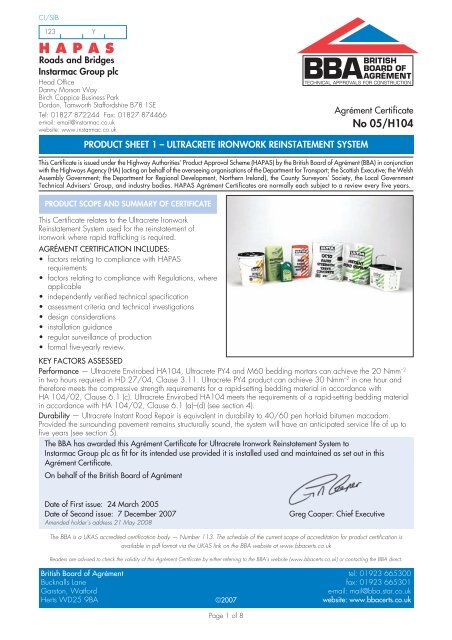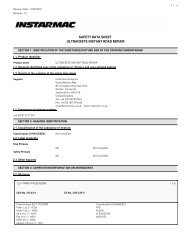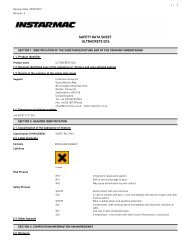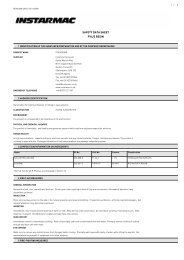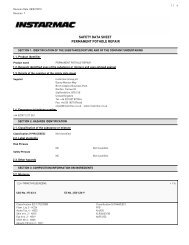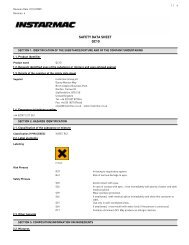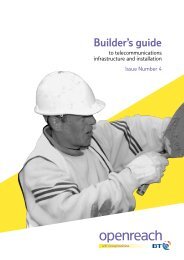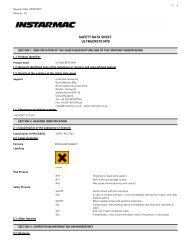bba hapas - Durey Castings
bba hapas - Durey Castings
bba hapas - Durey Castings
You also want an ePaper? Increase the reach of your titles
YUMPU automatically turns print PDFs into web optimized ePapers that Google loves.
CI/SfB<br />
123 Y<br />
H A P A S<br />
Roads and Bridges<br />
Instarmac Group plc<br />
Head Office<br />
Danny Morson Way<br />
Birch Coppice Business Park<br />
Dordon, Tamworth Staffordshire B78 1SE<br />
Tel: 01827 872244 Fax: 01827 874466<br />
e-mail: email@instarmac.co.uk<br />
website: www.instarmac.co.uk<br />
PRODUCT SHEET 1 – ULTRACRETE IRONWORK REINSTATEMENT SYSTEM<br />
PRODUCT SCOPE AND SUMMARY OF CERTIFICATE<br />
This Certificate relates to the Ultracrete Ironwork<br />
Reinstatement System used for the reinstatement of<br />
ironwork where rapid trafficking is required.<br />
AGRÉMENT CERTIFICATION INCLUDES:<br />
• factors relating to compliance with HAPAS<br />
requirements<br />
• factors relating to compliance with Regulations, where<br />
applicable<br />
• independently verified technical specification<br />
• assessment criteria and technical investigations<br />
• design considerations<br />
• installation guidance<br />
• regular surveillance of production<br />
• formal five-yearly review.<br />
Agrément Certificate<br />
No 05/H104<br />
This Certificate is issued under the Highway Authorities’ Product Approval Scheme (HAPAS) by the British Board of Agrément (BBA) in conjunction<br />
with the Highways Agency (HA) (acting on behalf of the overseeing organisations of the Department for Transport; the Scottish Executive; the Welsh<br />
Assembly Government; the Department for Regional Development, Northern Ireland), the County Surveyors’ Society, the Local Government<br />
Technical Advisers’ Group, and industry bodies. HAPAS Agrément Certificates are normally each subject to a review every five years.<br />
KEY FACTORS ASSESSED<br />
Performance — Ultracrete Envirobed HA104, Ultracrete PY4 and M60 bedding mortars can achieve the 20 Nmm –2<br />
in two hours required in HD 27/04, Clause 3.11. Ultracrete PY4 product can achieve 30 Nmm –2 in one hour and<br />
therefore meets the compressive strength requirements for a rapid-setting bedding material in accordance with<br />
HA 104/02, Clause 6.1 (c). Ultracrete Envirobed HA104 meets the requirements of a rapid-setting bedding material<br />
in accordance with HA 104/02, Clause 6.1 (a)–(d) (see section 4).<br />
Durability — Ultracrete Instant Road Repair is equivalent in durability to 40/60 pen hot-laid bitumen macadam.<br />
Provided the surrounding pavement remains structurally sound, the system will have an anticipated service life of up to<br />
five years (see section 5).<br />
The BBA has awarded this Agrément Certificate for Ultracrete Ironwork Reinstatement System to<br />
Instarmac Group plc as fit for its intended use provided it is installed used and maintained as set out in this<br />
Agrément Certificate.<br />
On behalf of the British Board of Agrément<br />
Date of First issue: 24 March 2005<br />
Date of Second issue: 7 December 2007<br />
Amended holder’s address 21 May 2008<br />
Greg Cooper: Chief Executive<br />
The BBA is a UKAS accredited certification body — Number 113. The schedule of the current scope of accreditation for product certification is<br />
available in pdf format via the UKAS link on the BBA website at www.<strong>bba</strong>certs.co.uk<br />
Readers are advised to check the validity of this Agrément Certificate by either referring to the BBA’s website (www.<strong>bba</strong>certs.co.uk) or contacting the BBA direct.<br />
British Board of Agrément tel: 01923 665300<br />
Bucknalls Lane fax: 01923 665301<br />
Garston, Watford<br />
e-mail: mail@<strong>bba</strong>.star.co.uk<br />
Herts WD25 9BA<br />
©2006 ©2007<br />
website: www.<strong>bba</strong>certs.co.uk<br />
Page 1 of 8
HAPAS Requirements<br />
Requirements<br />
The Highways Technical Advisory Committee (HiTAC) of HAPAS has agreed relevant assessment criteria for the system<br />
with the BBA. In the opinion of the BBA, the system, when manufactured and laid in accordance with the provisions of<br />
this Certificate, will meet the relevant requirements.<br />
Regulations<br />
Construction (Design and Management) Regulations 2007<br />
Construction (Design and Management) Regulations (Northern Ireland) 2007<br />
Information in this Certificate may assist the client, CDM co-ordinator, designer and contractors to address their<br />
obligations under these Regulations.<br />
See section: 2 Delivery and site handling (2.1 to 2.3)<br />
General<br />
This Certificate relates to the Ultracrete Ironwork Reinstatement System, used for the reinstatement of ironwork where<br />
rapid trafficking is required.<br />
The system is for use with a cover and frame up to and including Class D400 of BS EN 124 : 1994 in footways,<br />
footpaths, cycle-tracks and type 2, 3 and 4 carriageways.<br />
The system’s compressive strength and rapid-setting characteristics are adversely affected by low temperatures and it<br />
should not be installed at temperatures below 5°C.<br />
The installation of the system must be carried out by experienced specialist contractors in accordance with the<br />
procedures described in this Certificate and the manufacturer’s literature.<br />
Technical Specification<br />
1 Description<br />
1.1 The system comprises the following components:<br />
• Ultracrete Envirobed HA104 — a two component, non-shrink, fast setting, cementitious mortar, used to bed and<br />
level ironwork in highly trafficked locations, such as junctions and turning areas<br />
• Ultracrete PY4 SG and WG (summer and winter grades) — two component, fast-setting, polyester resin-based<br />
mortars used to bed and level ironwork in highly trafficked locations such as junctions and turning areas<br />
• Ultracrete M60 Rapid-Set Bedding Mortar — a fast-setting, cementitious mortar, used to bed and level ironwork<br />
• Ultracrete QC10 Rapid Strength Concrete — a two part, fast-setting cementitious concrete, used for backfilling<br />
around ironwork installations<br />
• Ultracrete Instant Road Repair (IRR) — graded Permanent Cold-lay Surfacing Materials (PCSMs) available in 6 mm<br />
and 10 mm surface course grades<br />
• Ultracrete SCJ Cold Joint Sealer — a spray-applied, cold joint sealant, applied to the vertical edges at joint interfaces.<br />
1.2 Quality control checks are carried out on the raw materials, during manufacture and on the finished products.<br />
2 Delivery and site handling<br />
2.1 The components are delivered to site in the packaging and weights given in Table 1. The tubs and bags bear the<br />
manufacturer’s name, address, mixing instructions and a hazard label in accordance with The Chemicals (Hazard<br />
Information and Packaging for Supply) Regulations 2002 (CHIP3) (see Table 2).<br />
Table 1<br />
Packaging and weights<br />
Component Weight Packaging type Shelf-life (1) (months)<br />
Ultracrete Envirobed HA 104<br />
powder 20 kg Bag 6<br />
liquid 2.5 litre Bottle 6<br />
Ultracrete PY4 SG and WG 25 kg Tub 6<br />
Ultracrete M60 25 kg Bag or tub 6<br />
Ultracrete QC10 25 kg Bag or tub 6<br />
Ultracrete Instant Road Repair 25 kg Bag 1<br />
25 kg Tub 6<br />
Ultracrete SCJ Cold Joint Sealer 750 ml Aerosol can 12<br />
(1) When stored in frost-free and dry conditions in accordance with the Certificate holder’s instructions.<br />
Page 2 of 8
Table 2<br />
Hazard classification<br />
2.2 When handling Ultracrete Envirobed HA104, Ultracrete M60 and QC10 on site, the normal health and safety<br />
procedures associated with cementitious materials should be observed.<br />
2.3 Health and Safety Data Sheets and the Control of Substances Hazardous to Health Regulations 2002 (COSHH)<br />
risk assessments for the works should be available to the purchaser and be maintained on site.<br />
Assessment and Technical Investigations<br />
The following is a summary of the assessment and technical investigations carried out on the Ultracrete Ironwork<br />
Reinstatement System.<br />
Design Considerations<br />
3 Use<br />
The Ultracrete Ironwork Reinstatement System is used for the reinstatement of ironwork, up to and including Class D400<br />
of BS EN 124 : 1994, in footways, footpaths, cycle-tracks and types 2, 3 and 4 carriageways, where rapid<br />
trafficking is required.<br />
4 Performance<br />
4.1 When installed in accordance with this Certificate, Ultracrete Envirobed HA104, Ultracrete PY4 and M60<br />
bedding mortars can achieve the 20 Nmm –2 in two hours as required for rapid construction in HD 27/04, Clause 3.11.<br />
4.2 In addition, Ultracrete PY4 can achieve 30 Nmm –2 in one hour and therefore meets the compressive strength<br />
requirements for a rapid-setting bedding mortar in accordance with HA 104/02, Clause 6.1(c).<br />
4.3 Ultracrete Envirobed meets the requirements of a rapid-setting bedding material in accordance with HA 104/02,<br />
Clause 6.1 (a)–(d).<br />
5 Durability<br />
5.1 Ultracrete Instant Road Repair is equivalent in durability to 40/60 pen (1) hot-laid bitumen macadam.<br />
(1) To BS EN 12591 : 2000.<br />
5.2 Provided the surrounding pavement remains structurally sound, the system will have an anticipated service life of<br />
up to five years.<br />
Installation<br />
Component<br />
Hazard classification<br />
Ultracrete Envirobed HA104 powder<br />
Irritant<br />
Ultracrete PY4 SG and WG<br />
Harmful, Flammable<br />
Ultracrete M60<br />
Irritant<br />
Ultracrete QC10<br />
Irritant<br />
Ultracrete Instant Road Repair<br />
Irritant<br />
Ultracrete SCJ Cold Joint Sealer Harmful, Extremely flammable<br />
6 General<br />
6.1 Precast concrete inspection chambers should comply with the requirements of BS 5911-4 : 2002 and<br />
BS EN 752-3 : 1997.<br />
6.2 The various components of the system should be installed within the thickness limits given in Table 3.<br />
Table 3<br />
Minimum and maximum material thickness<br />
Component<br />
Thickness (mm)<br />
Minimum<br />
Maximum<br />
Ultracrete Envirobed HA104 10 50<br />
Ultracrete PY4 SG and WG 5 50<br />
Ultracrete M60 10 75<br />
Ultracrete QC10 20 250<br />
6.3 Ultracrete Instant Road Repair is applied at a nominal 40 mm thickness in accordance with the Certificate holder’s<br />
installation instructions, Appendix A8, Compaction Requirements of the Specification for the Reinstatement of Openings<br />
in Highways and sections 8.13 and 8.14 of this Certificate.<br />
Page 3 of 8
6.4 Should other materials be used in conjunction with the system (for example to repair/rebuild the supporting<br />
structure) such materials should have a strength commensurate with the reinstatement system.<br />
6.5 The frame and cover should be aligned so as to ensure safe access to the reinstatement.<br />
7 Preparation<br />
7.1 A perimeter area, indicating the minimum width needed for excavation, is marked out around the existing frame<br />
of a failed installation (see Figure 1). This area should be extended to include any defects.<br />
7.2 The supporting structure must be of adequate size and strength to support the frame, cover and expected loading.<br />
7.3 The marked area is saw cut and excavated to uncover the flange of the existing cover and frame (see Figure 2).<br />
The existing cover and frame are removed using a suitable mechanical lifting device, taking care to avoid dropping<br />
loose materials in to the shaft.<br />
Figure 1 Failed ironwork Figure 2 Excavating failed ironwork<br />
7.4 All old bedding mortar should be removed and the supporting structure cut back or loose bricks removed until<br />
a sound base is achieved.<br />
7.5 The newly exposed substrate should be clean and structurally sound prior to commencing the reinstatement<br />
work.<br />
7.6 The depth needed to install the frame and cover level to the road surface should be determined, taking into<br />
account the depth of the frame and the manufacturer’s recommended maximum and minimum thicknesses (see<br />
Table 3).<br />
7.7 The finishing course of the supporting structure should be adjusted accordingly. For brick structures, levelling<br />
should be achieved prior to the installation of the final course.<br />
7.8 Concrete structures should be repaired using conventional concrete repair techniques and materials. The<br />
Certificate holder can advise on suitable materials.<br />
7.9 All old bedding material, loose paint, rust and any other debris should be removed from the frame prior to<br />
installation.<br />
8 Installation<br />
8.1 The products are mixed and laid strictly in accordance with this Certificate and the manufacturer’s<br />
recommendations.<br />
8.2 When using Ultracrete Envirobed HA104 and Ultracrete M60, the substrate should be wetted down prior to<br />
application of the mortar (see Figure 3).<br />
8.3 If packing materials are used as to support and level the frame, they should be compatible with the bedding<br />
mortar to be used. The Certificate holder can advise on suitable materials.<br />
8.4 The appropriate bedding mortar should be mechanically mixed as follows:<br />
• Ultracrete Envirobed HA104 — 20 kg of powder is mixed with approximately one 2.5 litre bottle of Envirobed<br />
HA104 liquid to obtain a stiff, non-slump mix with a uniform consistency. The amount of liquid required may be<br />
adjusted depending on the required consistency<br />
• Ultracrete PY4 SG or WG — the filler should be slowly added to the resin in the ratio of one complete tin of resin to<br />
one pack of filler/activator and mixed until a homogeneous mix is obtained. Part tins or packs should not be mixed<br />
• Ultracrete M60 — 25 kg of powder is mixed with approximately 3 litres of potable water to obtain a stiff, nonslump<br />
mix with a uniform consistency.<br />
8.5 The bedding materials should be immediately placed on the supporting structure, allowing a 5 mm excess<br />
thickness and used within ten minutes of mixing.<br />
Page 4 of 8
8.6 The frame is lowered into position using a suitable lifting device and placed on the bedding mortar ensuring that it<br />
is fully supported and checking that the frame does not overhang the mortar at any point. Care should be taken to<br />
avoid voids in the bedding material under the frame, particularly in the vicinity of the cover seating.<br />
8.7 The frame is tamped down into place, ensuring the correct level is obtained (see Figure 4). This can be checked<br />
by placing a straight edge over the frame and surrounding carriageway.<br />
8.8 Any holes within the frame should be infilled and the flanges of the frame enveloped by a minimum thickness of<br />
10 mm of the bedding material.<br />
8.9 Exposed surfaces of the bedding material around the frame must be float finished, ensuring any voids or loose<br />
material is removed and the inside surface pointed to a smooth finish.<br />
8.10 Once the bedding mortar has achieved sufficient strength the backfill material is placed. Ultracrete QC10 is<br />
mechanically mixed by adding the bag of cement to the sand/aggregate, and mixing with water (1) until the desired<br />
workability is obtained. The product may also be mixed by hand, if required, but care must be taken to ensure that a<br />
uniform consistency is achieved.<br />
(1) The volume of water required will vary depending on the moisture content of the aggregate. Typically, one to two litres of water will achieve the<br />
required workability.<br />
8.11 The area to be infilled should be wetted and the material placed within 10 minutes of mixing, to 40 mm below<br />
the required surface fill level, and compacted ensuring no voids are present (see Figure 5). The final surface is then<br />
rough floated to achieve a textured level surface ready to receive the Ultracrete Instant Road Repair.<br />
8.12 Once the Ultracrete QC10 has reached sufficient strength, all vertical edges of the excavated area and the<br />
manhole frame are sprayed with Ultracrete SCJ Cold Joint Sealer ensuring all the surfaces are covered (see Figure 6).<br />
Figure 3<br />
Apply the bedding mortar to the prepared<br />
substrate<br />
Figure 4<br />
Tamping and levelling of the frame<br />
Figure 5<br />
Backfilling using Ultracrete QC10<br />
Figure 6<br />
Application of Ultracrete SCJ Cold<br />
Joint Sealer<br />
Page 5 of 8
8.13 Ultracrete Instant Road Repair is applied to a depth of approximately 45 mm and compacted to 30 mm (see<br />
Figure 7).<br />
8.14 Vertical edges are sprayed again using the Ultracrete SCJ Cold Joint Sealer and Ultracrete Instant Road Repair is<br />
applied with a surcharge. The material is then compacted level with the existing surface course (see Figure 8).T<br />
8.15 An Ultracrete Envirobed HA104 or Ultracrete M60 installation should not be trafficked for a minimum of two<br />
hours following completion of the installation. This may be reduced to one hour for an Ultracrete PY4 installation.<br />
Figure 7<br />
Installation of Ultracrete Instant<br />
Road Repair<br />
Figure 8<br />
Final compaction of Ultracrete Instant<br />
Road Repair<br />
9 Tests<br />
9.1 Tests were carried out on the following components to determine:<br />
Ultracrete Instant Road Repair<br />
• skid/slip resistance<br />
Ultracrete Envirobed HA104<br />
• compression strength • tensile strength • workability • shrinkage<br />
Ultracrete PY4 SG and WG<br />
• shrinkage • accelerated ageing • pot life<br />
Ultracrete M60<br />
• freeze/thaw resistance • compressive strength • shrinkage • pot life<br />
Ultracrete QC10<br />
• freeze/thaw resistance • shrinkage • pot life<br />
Ultracrete SCJ Cold Joint Sealer<br />
• adhesion and corrosion protection.<br />
9.2 A reassessment was made of the data relating to Agrément Certificate No 01/H060 Ultracrete Instant Road Repair.<br />
10 Investigations<br />
10.1 An examination was made of independent test data relating to:<br />
Ultracrete Instant Road Repair<br />
• rut resistance<br />
• PSV and AAV values<br />
Ultracrete PY4 SG and WG<br />
• flexural strength<br />
• compressive strength<br />
Ultracrete M60<br />
• freeze/thaw resistance • compressive strength • chloride content<br />
Ultracrete QC10<br />
• compressive strength • chloride content<br />
Ultracrete Ironwork Reinstatement System<br />
• full-scale load test • watertightness.<br />
10.2 A postal user survey was conducted to investigate the performance of the product in service.<br />
10.3 A visit was made to a site to witness installation of the system.<br />
10.4 The manufacturing process was examined, including the methods adopted for quality control, and details were<br />
obtained of the quality and composition of the materials used.<br />
Page 6 of 8
Additional Information<br />
The management systems of Instarmac Group plc have been assessed and registered as meeting the requirements of<br />
ISO 9001 : 2000 by National Quality Assurance Ltd (Certificate No 6987/1).<br />
Bibliography<br />
BS 5911-4 : 2002 Precast concrete pipes, fittings and ancillary products — Specification for unreinforced and<br />
reinforced concrete inspection chambers (complementary to BS EN 1917 : 2002)<br />
BS EN 124 : 1994 Gully tops and manhole tops for vehicular and pedestrian areas. Design requirements, type<br />
testing, marking, quality control<br />
BS EN 1917 : 2002 Concrete manholes and inspection chambers, unreinforced, steel fibre and reinforced<br />
BS EN 752-3 : 1997 Drain and sewer outside buildings — Planning<br />
BS EN 12591 : 2000 Bitumen and bituminous binders — Specification for paving grade bitumens<br />
ISO 9001 : 2000 Quality management systems — Requirements<br />
HA 104/02 Design Manual for Roads and Bridges : Volume 4, Geotechnics and Drainage : Section 2, Drainage :<br />
Part 5, Chamber Tops and Gully Tops for Road Drainage and Services — Installation and Maintenance<br />
HD 27/04 Design Manual for Roads and Bridges : Volume 7, Pavement Design and Maintenance : Section 2,<br />
Pavement Design and Construction : Part 4, Pavement Construction Methods<br />
Specification for the reinstatement of openings in highways : DfT June 2002<br />
Page 7 of 8
Conditions of Certification<br />
11 Conditions<br />
11.1 This Certificate:<br />
• relates only to the product/system that is named and described on the front page<br />
• is granted only to the company, firm or person named on the front page — no other company, firm or person may<br />
hold or claim any entitlement to this Certificate<br />
• is valid only within the UK<br />
• has to be read, considered and used as a whole document — it may be misleading and will be incomplete to be<br />
selective<br />
• is copyright of the BBA<br />
• is subject to English law.<br />
11.2 References in this Certificate to any Act of Parliament, Statutory Instrument, Directive or Regulation of the<br />
European Union, British, European or International Standard, Code of Practice, manufacturers’ instructions or similar<br />
publication, are references to such publication in the form in which it was current at the date of this Certificate.<br />
11.3 This Certificate will remain valid for an unlimited period provided that the product/system and the manufacture<br />
and/or fabrication including all related and relevant processes thereof:<br />
• are maintained at or above the levels which have been assessed and found to be satisfactory by the BBA<br />
• continue to be checked as and when deemed appropriate by the BBA under arrangements that it will determine<br />
• are reviewed by the BBA as and when it considers appropriate<br />
• remain in accordance with the requirements of Highways Authorities’ Product Approval Scheme.<br />
11.4 In granting this Certificate, the BBA is not responsible for:<br />
• the presence or absence of any patent, intellectual property or similar rights subsisting in the product/system or any<br />
other product/system<br />
• the right of the Certificate holder to manufacture, supply, install, maintain or market the product/system<br />
• individual installations of the product/system, including the nature, design, methods and workmanship of or related<br />
to the installation<br />
• the actual works in which the product/system is installed, used and maintained, including the nature, design,<br />
methods and workmanship of such works.<br />
11.5 Any information relating to the manufacture, supply, installation, use and maintenance of this product/system<br />
which is contained or referred to in this Certificate is the minimum required to be met when the product/system is<br />
manufactured, supplied, installed, used and maintained. It does not purport in any way to restate the requirements of<br />
the Health & Safety at Work etc Act 1974, or of any other statutory, common law or other duty which may exist at the<br />
date of this Certificate; nor is conformity with such information to be taken as satisfying the requirements of the 1974<br />
Act or of any statutory, common law or other duty of care. In granting this Certificate, the BBA does not accept<br />
responsibility to any person or body for any loss or damage, including personal injury, arising as a direct or indirect<br />
result of the manufacture, supply, installation, use and maintenance of this product/system.<br />
British Board of Agrément tel: 01923 665300<br />
Bucknalls Lane fax: 01923 665301<br />
Garston, Watford<br />
e-mail: mail@<strong>bba</strong>.star.co.uk<br />
Herts WD25 9BA<br />
©2007<br />
website: www.<strong>bba</strong>certs.co.uk<br />
Page 8 of 8


